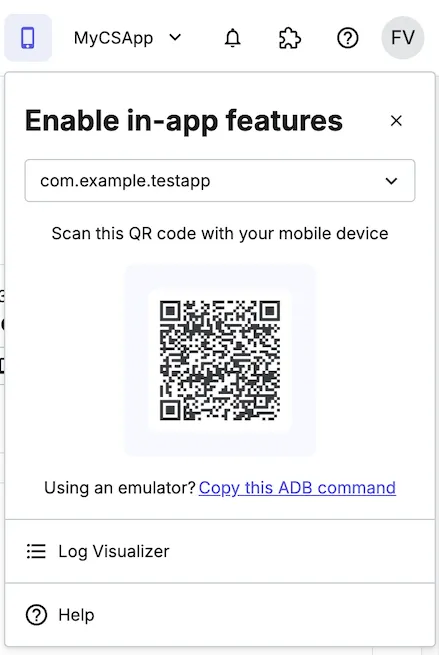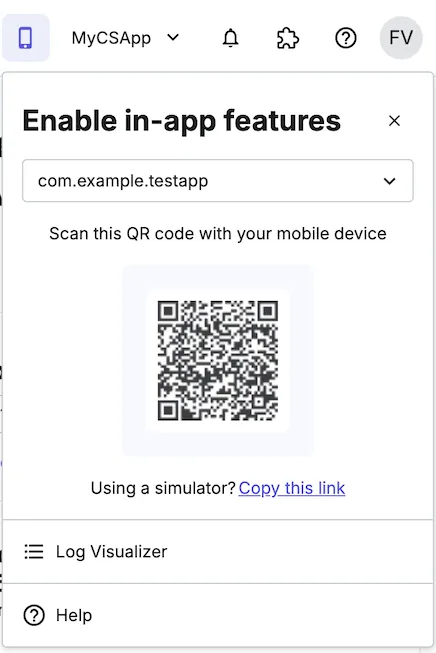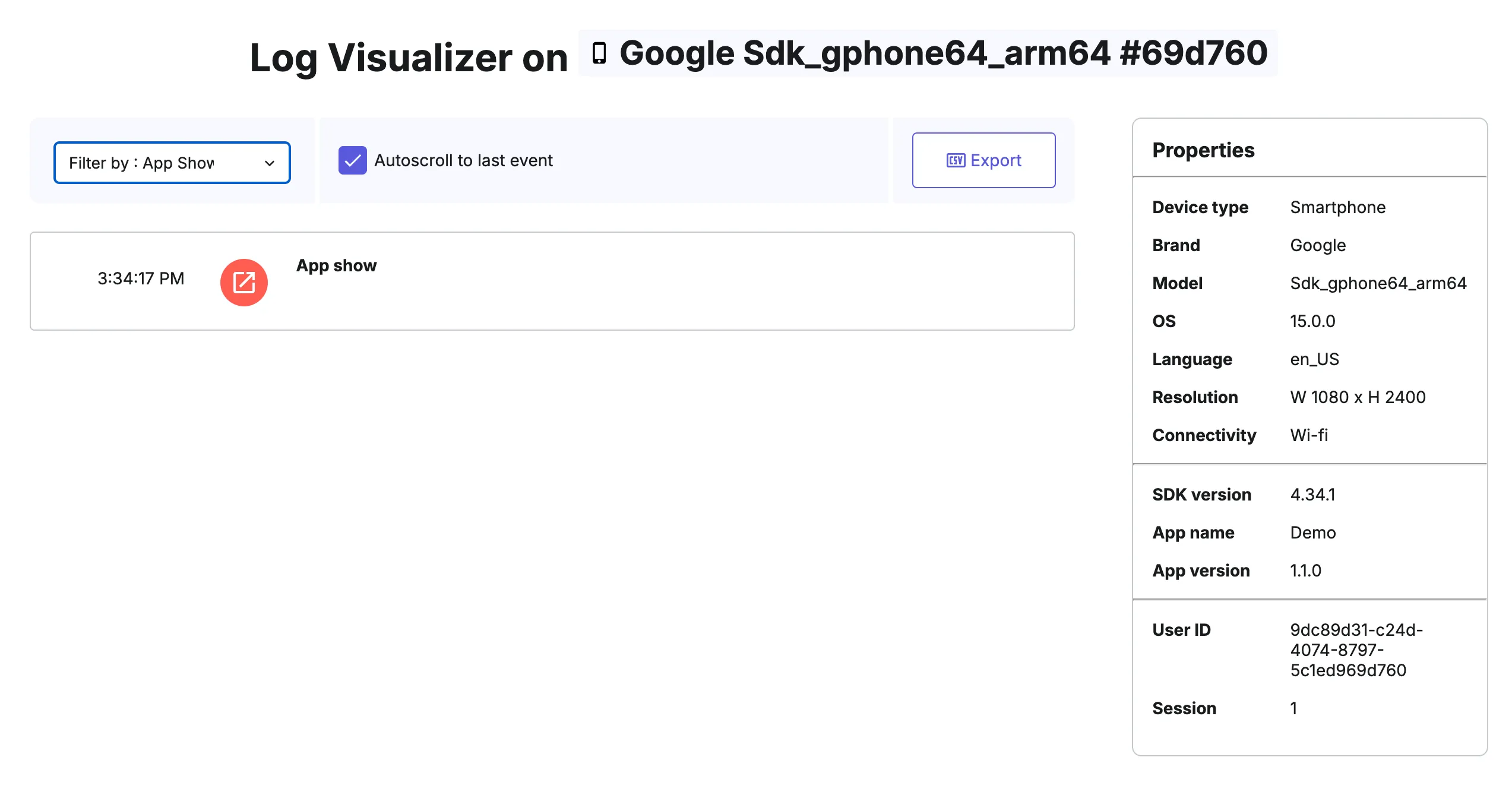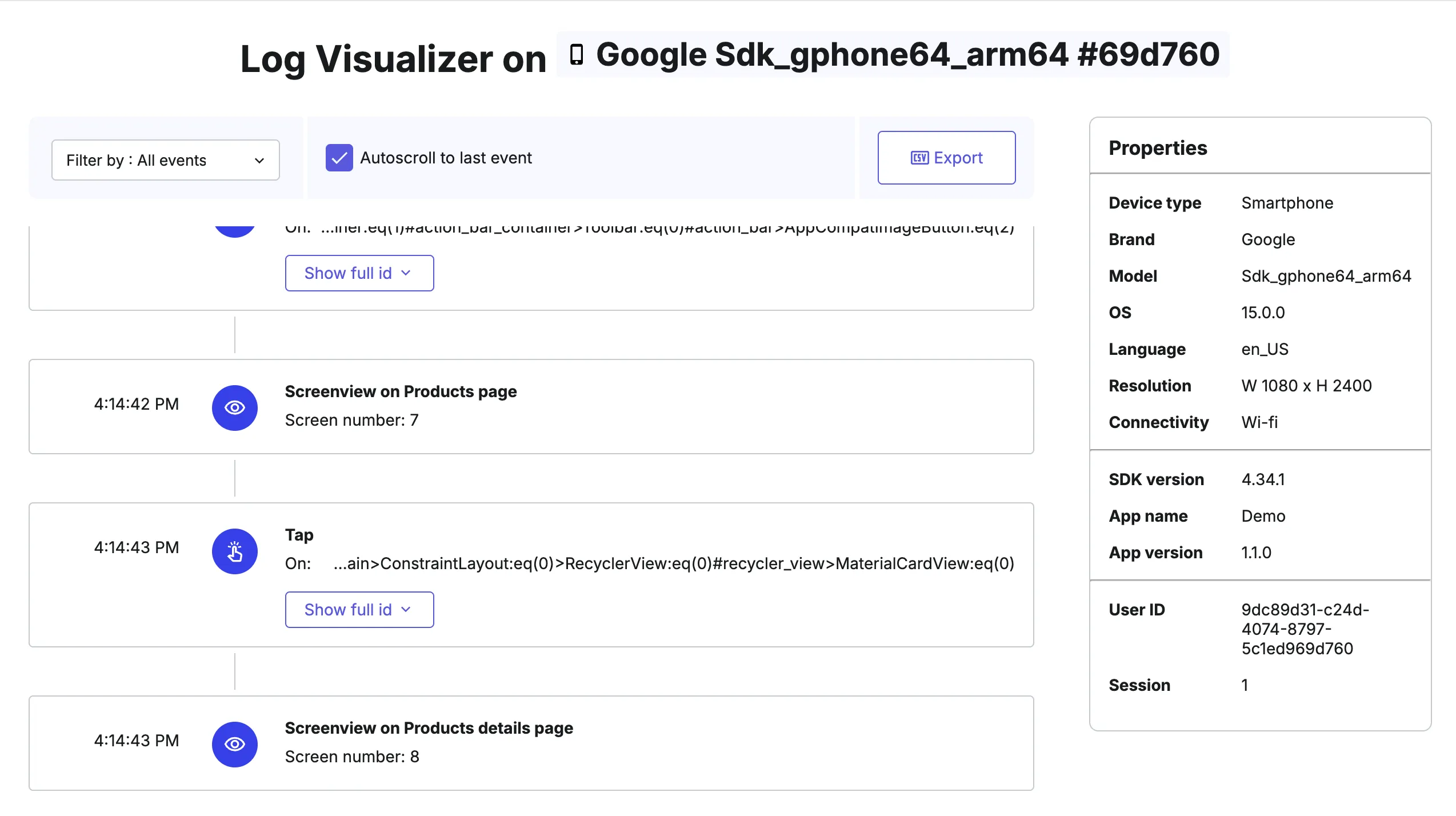Getting Started
Welcome to the SDK implementation guide!
This guide is designed to help you seamlessly integrate our SDK into your application. By following the outlined steps, you’ll be able to collect and analyze data from your app, within just a few minutes.
Install the SDK
Section titled Install the SDKThe Contentsquare Bridge for React Native integrates the Contentsquare SDKs for both iOS and Android with your React Native JavaScript code.
See Compatibility for more information.
Include the SDK
Section titled Include the SDKThe Contentsquare Bridge is available as an NPM package ↗, which includes the bridge and the necessary dependencies for specific versions of the SDKs.
To install the bridge, open a terminal and run the following commands from your application’s root directory:
npm install @contentsquare/react-native-bridgecd ios && pod installImporting the Bridge
Section titled Importing the BridgeThe Contentsquare module is the main module and the default export of our bridge.
The Currency module is only used to send Transactions, and contains all supported currencies.
import Contentsquare, { Currency } from "@contentsquare/react-native-bridge";You do not need to do anything to start the SDK. Now that the SDK is a dependency of your app, it will autostart itself when your application starts.
Validate SDK integration
Section titled Validate SDK integrationStart your application, and check logs for this output:
CSLIB: Contentsquare SDK 4.16.0 starting in app: com.example.testappCSLIB ℹ️ Info: Contentsquare SDK v4.16.0 starting in app: com.example.testappCheck the logs
Section titled Check the logsContentsquare provides logging capabilities that allow you to inspect the raw event data logged by your app in Android Studio, Xcode, or on the Contentsquare platform.
To view all logs, you must enable in-app features: logging is linked to in-app features being enabled or disabled.
Viewing local logs in IDE
Section titled Viewing local logs in IDETo view SDK logs:
- Plug your Android phone into your computer (or use an emulator)
- Open Android Studio and start your app
- Open the
Logcatview and select your phone or emulator - Filter logs by
CSLIB

-
Unless you are using a simulator, ensure the device you are using is connected to your Mac or is on the same Wi-Fi network.
-
Open the macOS Console app or Xcode.
For the macOS Console app, make sure info messages are included at Choose Action > Include Info Messages ↗.
-
Filter logs by
CSLIB.

Enable in-app features
Section titled Enable in-app featuresIn-app features are essential for your implementation, as it includes key functionalities like snapshot creation and replay configuration.
To enable in-app features within your app, you have to first make sure your app is launched in the background. Then, follow the appropriate method described as follows.
On a device: scan the QR code
Section titled On a device: scan the QR codeIn Contentsquare, select the Mobile icon in the menu top bar and scan the QR code with your phone.

In Contentsquare, select the Mobile icon in the menu top bar and scan the QR code with your phone.

On an emulator/simulator
Section titled On an emulator/simulatorIn Contentsquare, select the Mobile icon in the menu top bar then select your application ID, and “Copy this ADB command”.

In Contentsquare, select the Mobile icon in the menu top bar then select your Bundle ID, and select “Copy this link”. Paste it in Safari on your simulator to trigger the in-app features.

Contentsquare Log Visualizer
Section titled Contentsquare Log VisualizerLog Visualizer is a feature integrated into the Contentsquare SDK. As you navigate and interact with your app, it provides a live view of events detected by the SDK, visible directly on the Contentsquare platform ↗.
- Start your app.
- Select the Mobile icon in the menu top bar then select
Log Visualizer. - Select the device to inspect.
At this stage, you should see an ‘App start’ or ‘App show’ event being logged.


Get user consent
Section titled Get user consentContentsquare collects usage data from your app users. To start tracking, you need your users’ consent for being tracked.
User opt-in
Section titled User opt-inThe SDK treats users as opted-out by default.
To start tracking, forward user consent with optIn(). Calling this method generates a user ID and initiates tracking.
For example, you can call optIn() when the user accepts your app’s privacy policy or tracking terms.
import React, { useState } from "react";import { View, Text, Button } from "react-native";import Contentsquare from "@contentsquare/react-native-bridge";
const PolicyConsentScreen = () => { const [isTrackingAccepted, setIsTrackingAccepted] = useState(false);
const handleAcceptPolicy = () => { setIsTrackingAccepted(true); Contentsquare.optIn(); };
return ( <View> <Text>Please accept our privacy policy to proceed.</Text> <Button title="Accept Policy" onPress={handleAcceptPolicy} /> </View> );};
export default PolicyConsentScreen;Android permissions
Section titled Android permissionsWhen using the Contentsquare Flutter/React Native SDK on Android, the underlying native SDK requires specific permissions to function correctly.
These permissions are automatically included from the Contentsquare SDK into your app’s AndroidManifest.xml at build time.
For the full list and detailed explanations, you can refer to the Contentsquare Android SDK Required Permissions documentation.
Important
These permissions are mandatory and used exclusively for analytics purposes, in compliance with GDPR and CNIL (French regulation) requirements.
Track your first screens
Section titled Track your first screensContentsquare aggregates the user behavior and engagement at the screen level. Start your SDK implementation by tracking key screens like the home screen, product list, product details, or conversion funnel.
Sending screenview events
Section titled Sending screenview eventsScreen tracking is achieved by sending a screenview event each time a new screen is displayed on the user’s device.
Sending Screenview Events using the React Navigation Library
Section titled Sending Screenview Events using the React Navigation LibraryThe sending of screenview events can be handled within the NavigationContainer in React Navigation ↗, which centralizes the logic and helps avoid unnecessary calls.
// This associates the screen name sent to Contentsquare to the screen name defined in the codeconst screenEventByScreenName: Record<string, string> = { Home: 'Home', ProductList: 'Product List', ProductDetails: 'Product #1',};
export const Navigation = () => { const navigationRef = useNavigationContainerRef<RootStackParamList>(); const routeNameRef = useRef<string>();
return ( <NavigationContainer ref={navigationRef} onReady={() => { // Getting initial route name from navigation and sending a screen view event with Contentsquare SDK const currentRouteName = navigationRef.getCurrentRoute()?.name; if (currentRouteName && screenEventByScreenName[currentRouteName]) { Contentsquare.send(screenEventByScreenName[currentRouteName]); } }} onStateChange={() => { // Getting route name from navigation and sending a screen view event with Contentsquare SDK const currentRouteName = navigationRef.getCurrentRoute()?.name; routeNameRef.current = currentRouteName; if (currentRouteName && screenEventByScreenName[currentRouteName]) { Contentsquare.send(screenEventByScreenName[currentRouteName]); } }} > <RootNavigator /> <PrivacyManager /> </NavigationContainer> );};Implementation recommendations
Section titled Implementation recommendationsFrom a functional perspective, a screenview should be triggered in the following cases:
- When the screen appears on the device
- When a modal or pop-up is displayed
- When a modal or pop-up is closed, returning the user to the screen
- When the app is brought back to the foreground (after being minimized)
Tracking app launch
Section titled Tracking app launchMost events collected by the SDK require a screenview event to be sent first in order to associate the events with the correct screen. If a screenview event is not sent, the events will be discarded. To ensure proper tracking from the moment the app launches, trigger a screenview event immediately after the SDK has started.
Screen name handling
Section titled Screen name handlingIt is necessary to provide a name for each screen when calling the screenview API.
As a general rule, keep distinct screen names under 100. As they are used to map your app in Contentsquare, you will want something comprehensive. The screen name length is not limited on the SDK side. However, the limit is 2083 characters on the server side.
More on screen name handling.
Test your setup
Section titled Test your setupTesting your SDK implementation is essential to make sure data is being accurately captured and reported.
To test your setup, simulate user interactions in your app and check that the events are logged correctly in our analytics platform.
You can also use debugging tools such as Android Studio, Xcode, or Log Visualizer to monitor data transmission and ensure everything is running smoothly.
Visualize events in Contentsquare
Section titled Visualize events in ContentsquareUse Log Visualizer to view incoming events within the Contentsquare pipeline. This allows you to monitor the stream in real time.
By simulating user activity, you see incoming screenview and gesture events.


Visualize data in Contentsquare
Section titled Visualize data in ContentsquareIn Journey Analysis
Section titled In Journey AnalysisOpen Journey Analysis ↗ in Contentsquare and visualize the user journeys main steps across your app, screen by screen.

See how to use Journey Analysis on the Help Center ↗.
In Session Replay
Section titled In Session ReplayOpen Session Replay ↗ in Contentsquare and replay the full user session across your app.

See how to use Session Replay on the Help Center ↗
Sample app
Section titled Sample appTo explore some of these features in context, check our React Native sample apps.
react-native-sample-app
Sample apps illustrating how to use the Contentsquare Bridge for React Native in your app
Next Steps
Section titled Next StepsWhile screen tracking gives an overview of user navigation, capturing session, screen, or user metadata provides a deeper understanding of the context behind user behavior.
Our SDK offers a wide range of features to enhance your implementation, including Session Replay, Error Monitoring, extended tracking capabilities, and personal data masking.
Proceed with these how-to’s to refine your implementation.